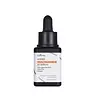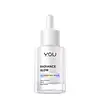What's inside
What's inside
 Key Ingredients
Key Ingredients

 Benefits
Benefits

 Concerns
Concerns

No concerns
 Ingredients Side-by-side
Ingredients Side-by-side

Water
Skin ConditioningNiacinamide 20%
SmoothingDipropylene Glycol
HumectantMethylpropanediol
SolventPropanediol
SolventArbutin
AntioxidantGlycerin
HumectantZinc PCA
HumectantSodium PCA
HumectantPortulaca Oleracea Extract
Skin ConditioningSodium Hyaluronate
HumectantSodium Acetylated Hyaluronate
HumectantHydrolyzed Hyaluronic Acid
HumectantHydrolyzed Sodium Hyaluronate
Skin ConditioningHyaluronic Acid
HumectantHydroxypropyltrimonium Hyaluronate
Potassium Hyaluronate
Skin ConditioningSodium Hyaluronate Crosspolymer
HumectantPinus Palustris Leaf Extract
TonicUlmus Davidiana Root Extract
Skin ConditioningOenothera Biennis Flower Extract
AstringentPueraria Lobata Root Extract
HumectantAmmonium Acryloyldimethyltaurate/Vp Copolymer
Adenosine
Skin ConditioningDipotassium Glycyrrhizate
HumectantTromethamine
BufferingButylene Glycol
HumectantAcrylates/C10-30 Alkyl Acrylate Crosspolymer
Emulsion Stabilising1,2-Hexanediol
Skin ConditioningHydroxyacetophenone
AntioxidantWater, Niacinamide 20%, Dipropylene Glycol, Methylpropanediol, Propanediol, Arbutin, Glycerin, Zinc PCA, Sodium PCA, Portulaca Oleracea Extract, Sodium Hyaluronate, Sodium Acetylated Hyaluronate, Hydrolyzed Hyaluronic Acid, Hydrolyzed Sodium Hyaluronate, Hyaluronic Acid, Hydroxypropyltrimonium Hyaluronate, Potassium Hyaluronate, Sodium Hyaluronate Crosspolymer, Pinus Palustris Leaf Extract, Ulmus Davidiana Root Extract, Oenothera Biennis Flower Extract, Pueraria Lobata Root Extract, Ammonium Acryloyldimethyltaurate/Vp Copolymer, Adenosine, Dipotassium Glycyrrhizate, Tromethamine, Butylene Glycol, Acrylates/C10-30 Alkyl Acrylate Crosspolymer, 1,2-Hexanediol, Hydroxyacetophenone
Water
Skin ConditioningPropanediol
SolventPPG-24-Glycereth-24
EmulsifyingButylene Glycol
HumectantMethyl Gluceth-20
HumectantHydroxyethyl Urea
HumectantNiacinamide
SmoothingBis-Ethoxydiglycol Cyclohexane 1,4-Dicarboxylate
EmollientSodium Hexeth-4 Carboxylate
CleansingPropylene Glycol
HumectantBetaine
HumectantCucumis Melo Fruit Extract
Skin ConditioningAcrylates/C10-30 Alkyl Acrylate Crosspolymer
Emulsion StabilisingHydroxyacetophenone
AntioxidantAminomethyl Propanol
BufferingGlycine Soja Seed Extract
Skin ConditioningCorallina Officinalis Extract
Skin ConditioningDipotassium Glycyrrhizate
HumectantDihydroxypropyl Arginine Hcl
HumectantPolymethylsilsesquioxane
Dimethicone
EmollientIsohexadecane
EmollientPEG-40 Hydrogenated Castor Oil
EmulsifyingPentylene Glycol
Skin ConditioningDisodium EDTA
4-T-Butylcyclohexanol
MaskingCaprylhydroxamic Acid
Sodium Hyaluronate
HumectantParfum
MaskingPEG-40 Stearate
EmulsifyingCetearyl Methicone
Skin ConditioningSteareth-2
EmulsifyingSteareth-21
CleansingPhenoxyethanol
PreservativeCaprylyl Glycol
EmollientSodium Benzoate
Masking10-Hydroxydecanoic Acid
Skin ConditioningMagnesium Ascorbyl Phosphate
Antioxidant3-O-Ethyl Ascorbic Acid
Skin ConditioningPrunus Yedoensis Leaf Extract
Skin ConditioningAscorbyl Tetraisopalmitate
AntioxidantWater, Propanediol, PPG-24-Glycereth-24, Butylene Glycol, Methyl Gluceth-20, Hydroxyethyl Urea, Niacinamide, Bis-Ethoxydiglycol Cyclohexane 1,4-Dicarboxylate, Sodium Hexeth-4 Carboxylate, Propylene Glycol, Betaine, Cucumis Melo Fruit Extract, Acrylates/C10-30 Alkyl Acrylate Crosspolymer, Hydroxyacetophenone, Aminomethyl Propanol, Glycine Soja Seed Extract, Corallina Officinalis Extract, Dipotassium Glycyrrhizate, Dihydroxypropyl Arginine Hcl, Polymethylsilsesquioxane, Dimethicone, Isohexadecane, PEG-40 Hydrogenated Castor Oil, Pentylene Glycol, Disodium EDTA, 4-T-Butylcyclohexanol, Caprylhydroxamic Acid, Sodium Hyaluronate, Parfum, PEG-40 Stearate, Cetearyl Methicone, Steareth-2, Steareth-21, Phenoxyethanol, Caprylyl Glycol, Sodium Benzoate, 10-Hydroxydecanoic Acid, Magnesium Ascorbyl Phosphate, 3-O-Ethyl Ascorbic Acid, Prunus Yedoensis Leaf Extract, Ascorbyl Tetraisopalmitate
 Reviews
Reviews

Ingredients Explained
These ingredients are found in both products.
Ingredients higher up in an ingredient list are typically present in a larger amount.
Acrylates/C10-30 Alkyl Acrylate Crosspolymer is a synthetic polymer. It is used to thicken and improve the texture of products. Due to its properties, it can prevent water and oil ingredients from separating.
Butylene Glycol (or BG) is used within cosmetic products for a few different reasons:
Overall, Butylene Glycol is a safe and well-rounded ingredient that works well with other ingredients.
Though this ingredient works well with most skin types, some people with sensitive skin may experience a reaction such as allergic rashes, closed comedones, or itchiness.
Learn more about Butylene GlycolDipotassium Glycyrrhizate comes from licorice root.
Extracts of licorice have demonstrated to have antibacterial, anti‐inflammatory, antiviral, antioxidant properties.
One component, glabridin, has extra potent antioxidant and soothing properties. It has also been found to block pigmentation from UVB rays in guinea pigs.
Licorice Root also contains a flavonoid. Flavonoids are a natural substance from in plants. Flavonoids also have antioxidant properties.
Another component, glycyrrhizin, has been found to have anti-inflammatory and antimicrobial benefits. This may make licorice root extract effective at treating acne. However, more research is needed to support this.
Liquiritin is one of the flavone compounds found in licorice. It has been found to help lighten skin by preventing tyrosinase from reacting with tyrosine. When the two react, protein is converted to melanin. Melanin is the substance in your body that gives your features pigmentation.
Licorice root is native to Southern Europe and Asia. It has been used in traditional Chinese medicine to help with respiratory issues.
Learn more about Dipotassium GlycyrrhizateHydroxyacetophenone is antioxidant with skin conditioning and soothing properties. It also boosts the efficiency of preservatives.
This ingredient is not irritating or sensitizing.
Niacinamide is a multitasking form of vitamin B3 that strengthens the skin barrier, reduces pores and dark spots, regulates oil, and improves signs of aging.
And the best part? It's gentle and well-tolerated by most skin types, including sensitive and reactive skin.
You might have heard of "niacin flush", or the reddening of skin that causes itchiness. Niacinamide has not been found to cause this.
In very rare cases, some individuals may not be able to tolerate niacinamide at all or experience an allergic reaction to it.
If you are experiencing flaking, irritation, and dryness with this ingredient, be sure to double check all your products as this ingredient can be found in all categories of skincare.
When incorporating niacinamide into your routine, look out for concentration amounts. Typically, 5% niacinamide provides benefits such as fading dark spots. However, if you have sensitive skin, it is better to begin with a smaller concentration.
When you apply niacinamide to your skin, your body converts it into nicotinamide adenine dinucleotide (NAD). NAD is an essential coenzyme that is already found in your cells as "fuel" and powers countless biological processes.
In your skin, NAD helps repair cell damage, produce new healthy cells, support collagen production, strengthen the skin barrier, and fight environmental stressors (like UV and pollution).
Our natural NAD levels start to decline with age, leading to slower skin repair, visible aging, and a weaker skin barrier. By providing your skin niacinamide, you're recharging your skin's NAD levels. This leads to stronger, healthier, and younger looking skin.
Another name for vitamin B3 is nicotinamide. This vitamin is water-soluble and our bodies don't store it. We obtain Vitamin B3 from either food or skincare. Meat, fish, wheat, yeast, and leafy greens contain vitamin B3.
The type of niacinamide used in skincare is synthetically created.
Learn more about NiacinamidePropanediol is an all-star ingredient. It softens, hydrates, and smooths the skin.
It’s often used to:
Propanediol is not likely to cause sensitivity and considered safe to use. It is derived from corn or petroleum with a clear color and no scent.
Learn more about PropanediolSodium Hyaluronate is hyaluronic acid's salt form. It is commonly derived from the sodium salt of hyaluronic acid.
Like hyaluronic acid, it is great at holding water and acts as a humectant. This makes it a great skin hydrating ingredient.
Sodium Hyaluronate is naturally occurring in our bodies and is mostly found in eye fluid and joints.
These are some other common types of Hyaluronic Acid:
Learn more about Sodium HyaluronateWater. It's the most common cosmetic ingredient of all. You'll usually see it at the top of ingredient lists, meaning that it makes up the largest part of the product.
So why is it so popular? Water most often acts as a solvent - this means that it helps dissolve other ingredients into the formulation.
You'll also recognize water as that liquid we all need to stay alive. If you see this, drink a glass of water. Stay hydrated!
Learn more about Water